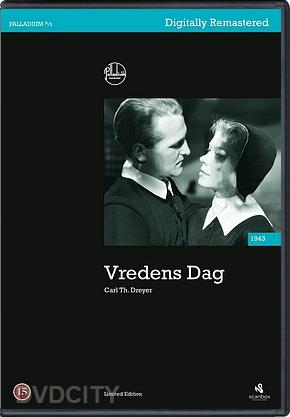|
Vis stor: []
|
| Beskrivelse: [ Dansk Engelsk ]
Den gamle almuekone Herlofs Marte bliver brændt efter grufulde forhør. Det er byens præst, Absalon Pederssøn, der underskriver hendes dødsdom. Denne handling fører ham imidlertid ud i de værste samvittighedskvaler, og livet i præstegården er som forbandet. Præstens unge kone Anne har nemlig forelsket sig... Beskrivelse: [ Dansk Engelsk ]
Day of Wrath is generally regarded to be one of Dreyer's greatest works. Its mood is sombre and intense; the narrative pace is steady and deliberate, presenting horrific events with chilling restraint; and it deals with all his prime concerns: religious faith, the supernatural, social intolerance, innocence and guilt, and the clash between society and the individual – especially the individual woman.
This is a dark and powerful tale of love and betrayal, and of a community gripped by an obsessive fear of witchcraft. It is adapted from a 1909 stage play, Anne Pedersdotter, by Norwegian writer Hans Wiers-Jenssen. Dreyer said that he saw in it 'possibilities for great monumental visual effects – four or five figures as sharply defined as medieval wood sculptures'. He used light and darkness to express moral and emotional concerns, with severe, black-garbed figures set against stark white walls, and opposing lines of force creating tensions within the frame.
In early seventeenth-century rural Denmark an old woman is hunted down and burned as a witch, despite the efforts of the parson's young wife, Anne, to save her. Anne (whose own mother had been suspected of being a witch), is possessed by a secret passion for her stepson, a young man of her own age, and when her elderly husband dies she finds herself accused of using witchcraft to cause his death.
Seen by some as an allegory of the Nazi occupation of Denmark and by others as an indictment of male domination and suppression of strong women, Day of Wrath has an extraordinary emotional intensity achieved by superb performances, and is a stunning example of the humanity, artistic power and technical mastery of Dreyer's art. |
|
| Instruktør:
Carl Theodor Dreyer
Skuespillere:
Albert Høeberg
Anna Svierkier
Dagmar Wildenbrück
Emanuel Jørgensen
Emilie Nielsen
Hans Christian Sørensen
Harald Holst
Kirsten Andreasen
Lisbeth Movin
Olaf Ussing
Preben Lerdorff Rye
Preben Neergaard
Sigrid Neiiendam
Sigurd Berg
Sophie Knudsen
Thorkild Roose
Producent:
Carl Theodor Dreyer
Tage Nielsen
Forfatter:
Carl Theodor Dreyer
Hans Wiers-Jenssen
Hans Wiers-Jenssens
Mogens Skot-Hansen
Paul La Cour
Poul Knudsen
|



 Tilladt fra 15 år.
Tilladt fra 15 år.